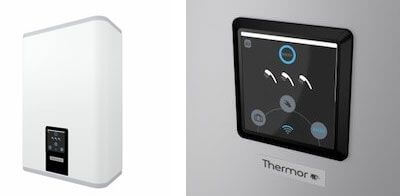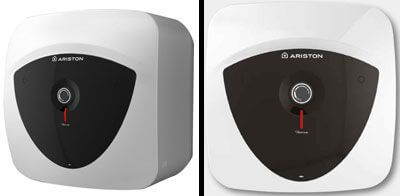Home / Hot Water Production Systems (DHW) / Advantages and disadvantages of an electric instant water heater (español – français – italiano)
When and why install an electric instant water heater?
Share this page
Electric instant water heater: operating principle
On opening the hot water valve, the cold water enters the water heater by vacuum and is instantly converted in hot water by a copper resistance. Unlike the tank, water is not stored to be heated at regular periods. Water is heated only when needed, only for the desired amount. The 2 main types are the gas tankless water heaters and the electric tankless water heaters.
The advantages of an instant water heater
The small size allows to gain some living space
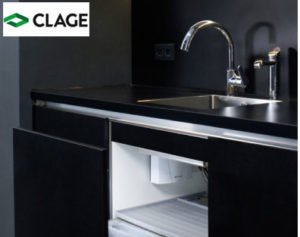
In terms of size, the instant water heater is self-sufficient: no security group to add as for the tank water heater, no bulky tank, etc.
In some cases, the tankless water heater can reduce the space needed to heat the water. At the time when each m2 costs more and more, this solution can be particularly useful in small spaces. For example, in the absence of a centralised heating system (e.g.: electric heating, not enough space to place a tank, technical impossibility, etc.), this solution will produce domestic hot water (sink, washbasin, shower). It can be even more useful if all water points are short range: only one water heater can be enough for all needs of a small apartment (1 person).
Instant water heaters can be installed under the counter (under the kitchen counter, under the sink), in the closets, or fixed to the wall as for the bigger models. For example, for a shower, a 6 kW model will have the following dimensions: 18 cm x 30 cm x 12 cm (depth) for a 3 kg weight.
Reduces and facilitates the works
This is an ideal solution when, in renovation, it is very complex, expensive or unsightly to run water pipes from one room to another. Only a cold water supply and a socket are required. The electric solution also avoids the introduction of exhaust conducts of combustion gases as for a gas water heater. Therefore it does not require any extraction nor special ventilation. The absence of any special security elements makes its installation extremely simple.
This device is particularly interesting in renovation or when changing the function of a room into a bathroom. For secondary houses or guest rooms, we avoid to heat unnecessarily the tank and to develop bacterias (because the water stagnates). For main residences, or in large buildings with long water pipes, the solution can be particularly interesting to avoid the unnecessary consumption of cold water as long as the hot water from the boiler arrives to the draw-off point.
Compact, easy to handle, the device is extremely simple and quick to install. Some can be installed in any direction, or even implanted in a furniture.
Unlimited amount of hot water contrary to a tank water heater
In the case of large families, even with a large water storage tank (cumulus), it is possible to run out of hot water. You must then wait several hours before obtaining hot water again. This is also the case for secondary residences with the electricity turned off during the absence. The instant heater is a flexible solution without disruption in “service”. The service is continuous regardless of the demand (provided that the flow is not too high).
Get hot water instantly (no waiting) and at a desired temperature
Always install the water heater close to the water inlet source. Indeed, before the first drawing, the pipes are filled with cold water on the distance between the device and the shower (or sink). This is even more problematic when your need of water is low and punctual (if you must wash your hands with hot water, it is useless to draw litres of cold water). The aim of such devices is to decentralise the hot water production source.
Do not multiply simultaneous draw sources. Indeed, it is possible to serve multiple points of water drawing from the same source, but not simultaneously. Otherwise, you would have to oversize the water heater which would lose its main interest: its compactness.
Thanks to the setting available on the device it is possible to set the desired temperature according to the needs (kitchen sink, washbasin, shower).
Energy savings… interesting solution
Water savings
Placed close to the water source, it can allow to save water. Indeed, the hot water distances are shorter because the device is placed near the drawing point, therefore there are less energy loss (storage and distribution are eliminated) and less cold water is wasted (while waiting for the hot water passing through the pipes). Note, a household consumes in average 80 to 100 litres of hot water (40-45°C) per day.
The energy savings associated with decentralised production systems
The need of space heating keeps declining due to the eco-design and regulatory constraints. Heat the water at 60 degrees (such as the heating) for domestic hot water is a waste of energy. It is therefore entirely appropriate to separate the heating system from a domestic hot water heating system!
Different energy losses of a centralised hot water production system with smart loop. For a single house, these losses correspond to at least 40 % of the total energy requirement!
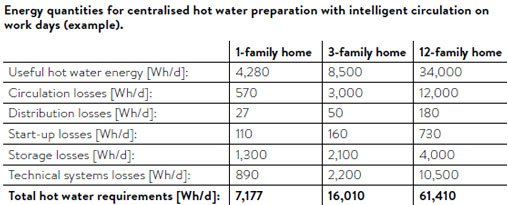
Source: GLACE / report Forschungsgesellschaft für Energiewirtschaft mbH in collaboration with the IUT in Munich, Nº FfE ZVEI-01, 2011
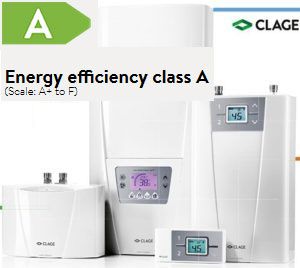
Different needs: different flows, different temperatures…
| Sink | Use: less than 20 seconds. Flow: 2 litres per minute. Water at 35°C. Is it appropriate to wait the hot water to arrive and once it is there to mix it (mixer, lever tap) with cold water to achieve the right temperature? The instant water heater provides the right amount of water, instantaneously, at the right temperature. |
| Kitchen | Use: 2 minutes. Flow: 5 litres per minute. Water at 48°C. Is it appropriate to wait the hot water to arrive and once it arrives to the tap to mix it with cold water (mixer) not to get burnt? |
| Shower | Use: less than 5 minutes. Flow: 8 litres per minute. Water at 38°C. Hot water is delayed: neither pleasant, nor ecological, nor economical. |
Quality instant water heater = water consumption reduced, less energy used, less CO2!
In decentralised domestic hot water production systems (DHW), only the necessary amount of water is heated. No hot water storage in the tank, no circulation pumps, no hot water distribution to elaborate, etc…
Gas tankless water heaters consume 15 to 20€/month as regards the cost of operation for a shower and a sink. A hot water tank with a gas source costs approx. 30€/month for a 300 litres tank.
The electric water heater works rarely, only when water drawing. However, an instant water heater consumes in average 45A or 9kW to properly feed a shower. This means that your electricity subscription must be adapted to this very high instantaneous demand. This the main inconvenience of this type of equipment. The power cable must be of section 6 mm2 in 220V, 32A fuse, 9KVA subscription.
The electric water heaters are quite a good deal. They consume a lot but for a short period of time. The overall energy savings (water, electricity or gas, absence of maintenance) are not easy to assess because it depends on the consumption and the existing DHW.
Suitable for the distribution of hot water… in small quantity
This type of device is not intended to heat domestic water for the entire house. It is on the other hand suitable for the production of hot water for sinks and showers. To obtain interesting flows for showers, high powers are required (at the limit of the capacities of standard electric subscriptions of 9KVA = subscription of 45A). The higher is the flow required, the more the water temperature drops. That’s the reason why it is strongly recommended to add a “water saver” faucet aerator (or a bath shower mixer mixing the air and water) to reduce the flow while having a good feeling of comfort (therefore with less water).
Zero maintenance or reduced maintenance, significant life time
The “harder” the water from the public water supply is (Th degree – degree of hardness or °f) or has a corrosive character (amount of nitrates, chlorides, sulfates), the more frequent the maintenance should be. In gas models, emptying the unit (for elimination of limestone deposits – limescale) may require the use of a drain kit at a variable rate, at least once a year. Electric models do not imply any maintenance or for some models a resistance change every 10 years approximately. So this is a maintenance-free device which does not request any annual technical inspection.
Compared to hot water tanks or some boilers whose life time is between 10 and 15 years, the life time of tankless water heaters is higher, within the range of 15 to 20 years. These are very reliable devices.
What power to choose for an electric instant water heater?
The power of a water heater required depends directly on the demand. We suggest the following powers (for an incoming water at 15°C) to limit the temperature drops and jolts (alternation of hot and cold water):
- less than 4 kw for a small washbasin (with a flow of 2 to 3 litres per minute for a temperature of 38°C) in 220V – starting from 150€
- from 4 to 6 kw for a washbasin (with a flow of 2 to 4 litres per minute for a temperature of 38°C à 42°C) in 220V – starting from 150€
- from 7 to 11 kw for a sink (with a flow of 5 litres per minute for a temperature of 35°C to 50°C) in 220V – starting from 200€
- approx. 9 kw for a shower (with a flow of 5 litres per minute for a temperature of 35°C to 45°C) in 220V – starting from 300€
- from 11 to 27 kw for a shower or a bath (with a flow of 6 to 10 litres per minute for a temperature of 33°C to 55°C) in 400V – starting from 500€
- from 30 to 50 kw (400V three phase) for commercial use (ERP)
Of course, if the temperature of the entering cold water drops (winter, in the mountains, etc.) the flow, for a given temperature, will drop the same way. Or you’ll have the same flow, but at a lower temperature.
Its flow at a given temperature is function of its power, it must be associated with a regulator (limiter) of flow corresponding to the draw point level. This is why manufacturers often offer faucets and hand showers.
What are the recent innovations in matters of instant water heaters?
The main ongoing innovations and innovations for the near future are:
- The provision of the temperature, adjustable to the degree by electronic control.
- Smart Home: integrated electronic control to manage (via smartphone) the duration of use, water and energy consumption, the costs for the selected period. The control by smartphone for models built in your furniture.
- The reduction of required electric power and the operation even in regions where the water from the public water supply is very cold.
- The power control based on the instantaneous demand (electronic control) even at low water pressure (1 bar).
- The dynamic regulation of the flow (actuator).
- The adaptation to solar energy to be connected to it thus to compensate the periods without sunshine.
Read also: Article on compact mini water heaters
KOSPEL

The KOSPEL company is a Polish manufacturer specialising in the production of electric instant water heaters, electric boilers, etc. KOSPEL provides all the power ranges up to 36kW in 220V or 400V, with or without electronic regulation. The technology used allows to operate even in conditions with low water pressure (starting from 1 bar).
CLAGE

The German company CLAGE is one of the leaders in the manufacture of economic instant water heaters with electronic control. All models are energy class A. Many models are miniaturised and especially designed for domestic uses (sinks, washbasins, showers, baths). CLAGE company offers an instant water heater including a bare tube IES® heating system with a replaceable heating cartridge which ensures a longer lifetime of the device. The remplacement is very simple.


STIEBEL ELECTRON

The German manufacturer STIEBEL specialises in the manufacture of renewable energy equipments, domestic hot water production, heating and air-conditioning. All the instant water heaters from the DHC range (compact, up to 8.8 kW), hydraulic control, were especially designed for single-phase 220V power supply. They are suitable to operate in areas with low water pressure.
ZIP WATERS

ZIP WATER is an Australian manufacturer of domestic hot water instant water heater solutions. Distributed in 60 countries, electronically controlled tankless water heater ranges meet all needs of water heating (washbasin, sink, shower, etc.) from 3.5 kW to 27kW (regulated at 50°C o 60°C maximum). Advanced features are integrated as the automatic adjustment of the heating power depending on the demand and pressure to limit temperature variations.
ARISTON

The Italian brand ARISTON, develops a range of instant water heaters and very low capacity tank water heaters (eg: 20 litres), capable of heating your water (∆T=40°C) in less than 20 minutes. The instant water heaters are dimensioned for showers with low electric power (3.3 kw – 220v – for a maximum flow rate of 8 litres per minute).
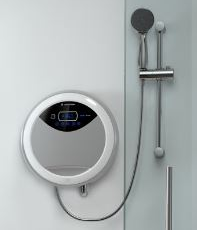
ariston-instant-water-heater
RHEEM

RHEEM is an American manufacturer distributed in over 75 countries. Rheem has many brands in the areas of heating, air-conditioning and hot water production. Its innovations has been subject of numerous awards and patents. The company manufactures innovant tankless water heaters.
BOSCH

The German manufacturer BOSCH produces and distributes in the USA instant water heater ranges (Electric Tankless Water Heaters) for domestic and professional use, whether it is for a single sink or for the whole house. The efficiency of the equipments is from 97% to 98%.
FOX20



